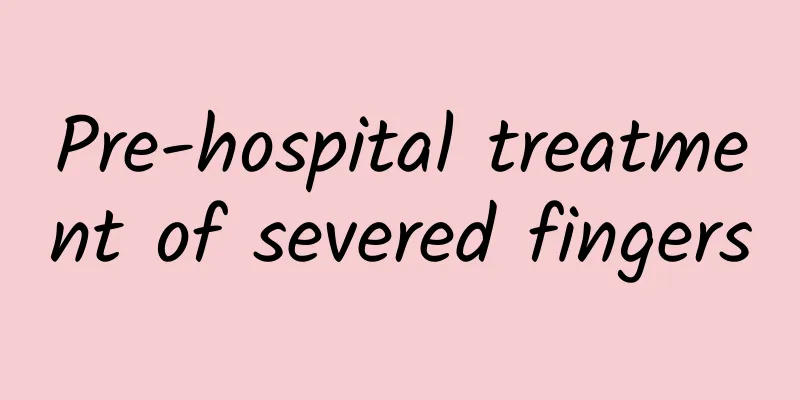Pre-hospital treatment of severed fingers

|
Finger amputation is a common accidental injury. Once it happens, timely and effective pre-hospital rescue and treatment will directly affect the patient's treatment outcome and recovery. Here is some knowledge about finger amputation, such as common causes, pre-hospital treatment methods, etc. I hope that everyone can provide prompt and effective treatment when encountering such emergencies. 1. Concepts related to amputation 1.1 Severed finger: A finger whose tissue is completely or partially severed due to surgery or trauma is called a "severed finger". 1.2 Replantation of severed fingers: It is a surgery that uses microsurgical techniques to perform debridement, bone fixation, nerve repair and other operations on partially or completely severed fingers, suturing the fingers back to their original position, allowing them to survive completely and restore certain functions. 2. Common causes of finger amputation The success rate is higher for injuries caused by sharp objects such as paper cutters, scissors, glass, punching machines, etc. Multi-blade injuries caused by flywheels, fans, harvesters, etc. These cuts are more serious. Since the tissue damage around the cut surface is more serious, although the replantation surgery is very difficult, as long as you work hard, you can still have a chance of success. 3. Pre-hospital treatment of severed fingers 3.1 On-site first aid If a finger is crushed by the machine, the machine must be stopped immediately and the severed finger must be removed as soon as possible. Never use the method of reversing the machine to remove the finger to avoid causing secondary injury to the limb. 3.2 Hemostasis Do not use belts, handkerchiefs, leather tubes, etc. to tie the wrists. This will not only fail to stop bleeding, but will also aggravate bleeding and even cause finger necrosis. Tying the wrists will not stop bleeding, but will only block venous return and cause more bleeding. The correct way to stop bleeding is to use clean cotton products to apply pressure to the bleeding area. This is more effective, safer, and has no side effects. 3.3 Cleaning the wound Pay attention to the cleanliness of the wound to minimize the chance of infection. If the wound is mixed with foreign matter or dust, rinse it in time to prevent foreign matter from remaining in the skin and forming black spots. If the amount of bleeding is relatively small and the injury is not serious, you can cover the wound with a band-aid after cleaning. It is generally not recommended to use hemostatic powder or apply red medicine. 3.4 Wound dressing If the wound is serious, after cleaning the wound, you can apply antibacterial ointment such as Bactroban. Do not apply gentian violet on the wound to avoid affecting the doctor's judgment of the injury. In general, you can use bandages, gauze, clean cotton products or sterilized dressings or bandages until the wound is completely healed. For deeper and longer wounds, if the bleeding has stopped, it is recommended to go to the hospital for examination to see if stitches are necessary or use skin adhesives for treatment (within 8-12 hours) to avoid delaying treatment. Prevent re-contamination, which can prevent the wound from being invaded by external bacteria again. (Not related to bandaging of severed fingers) 3.5 Proper Fixation A broken finger requires some simple fixation, and you should call 120 or go to the hospital as soon as possible to prevent the injured finger from getting worse. In other words, if the finger is not completely separated, if it is not fixed and allowed to move freely, it may damage the blood vessels and nerves that were not damaged. The correct way is to temporarily fix it with iron sheets or small wooden boards, which can relieve pain. During the transportation process, the injured person should lie flat and raise the injured finger. 3.6 Storage and transportation of severed fingers In order to prevent finger disability, you should not throw away the severed finger casually after it is severed. You should store the severed finger properly. The method is as follows: 3.6.1 Ice bucket method: Place the severed finger in a dry, sealed, clean plastic bag, tie the bag tightly, and then place it in an ice bucket. Add ice every once in a while, then cover the bucket (if there is no ice, you can use iced mineral water or ice cream instead to keep the severed finger in an environment of 0~4℃. However, do not let the severed finger come into direct contact with ice water or ice cubes, otherwise it may get frostbite.) Send the severed finger and the patient to the hospital. 3.6.2 Ice bag method: Put the finger into a sealable plastic bag, and then put it into a plastic bag filled with ice cubes, and seal the bag tightly. Be careful not to let the severed finger come into direct contact with the ice cubes. Send the severed finger and the patient to the hospital. Try to complete the replantation operation within 6-8 hours. Do not immerse the severed finger in disinfectant, alcohol, saline and other liquids for transportation to avoid dehydration or edema of cell tissue. This will damage the tissue structure of the severed finger, thereby affecting the survival rate of the replantation and significantly reducing the success rate of the operation. If the severed finger is dirty and needs to be rinsed, it must be rinsed with normal saline. Conclusion: In short, finger amputation is a sudden accidental injury. Through scientific pre-hospital treatment, such as correct hemostasis and bandaging methods, the patient's pain and complications can be minimized and the success rate of finger replantation can be improved. I hope everyone can master the correct pre-hospital treatment of finger amputation, provide timely rescue in emergency situations, and protect the health of themselves and others. Author: Yu Jiejing Deng Jianling Department of Bone and Pain Management, Wuzhou Red Cross Hospital |
<<: How to prevent osteoporosis in middle-aged and elderly people through diet therapy
>>: Stages and symptoms of pressure injuries
Recommend
What causes lower back pain during pregnancy?
It is normal for female friends to experience bac...
No one dares to marry a woman with this kind of smell
Private odor, this embarrassing but real problem,...
How to make a girl's voice thinner
Although compared with boys, the changes in girls...
Application of Octreotide PET/CT in Neuroendocrine Tumors
Author: Shi Xue Reviewer: Zhao Yinlong Case 1 The...
What causes abdominal pain during menstruation?
Nowadays, the pace of life is very fast and the w...
Counterpoint: Foldable phone display shipments to decline year-on-year in Q3 2024
The latest data from Counterpoint Research shows ...
Symptoms of gynecological diseases
The symptoms of gynecological diseases are usuall...
Is cervical polyp surgery painful?
Cervical polyps are one of the gynecological dise...
Can ovarian shrinkage return to normal?
There are many ovarian diseases that women may su...
The causes of inverted nipples
The condition of the breasts directly reflects th...
How to determine fetal arrest
Under normal circumstances, the baby's develo...
Uterine fibroid shape
Uterine fibroids are a common gynecological disea...
World Salt Reduction Week丨52-year-old woman caught because of "salt"! Experts: This eating habit is very dangerous
Can eating salt be dangerous? Recently, Ms. Xie f...
How to exercise for sagging breasts
Sagging breasts are a phenomenon that many female...
The menstrual flow is small and full of blood clots
Nowadays, people are under more and more work pre...









